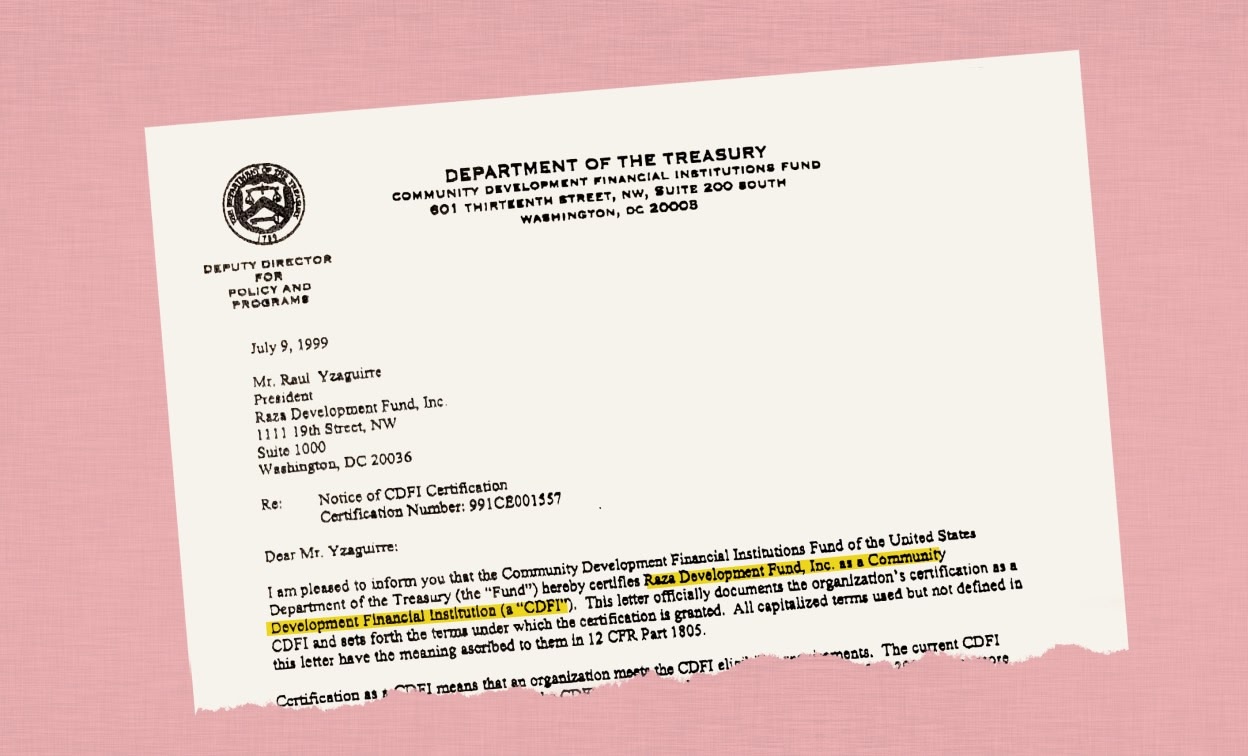A bold idea leads to a new financial institution and a pathway to opportunity.

A milestone moment in our history—this letter from the U.S. Treasury marked RDF’s official certification as a CDFI.
As the 20th century drew to a close, America was brimming with optimism. The economy was booming, fueled by the longest peacetime expansion in U.S. history and a tech revolution that promised a new era of prosperity. The country’s population had reached 272 million, with Latinos emerging as the fastest-growing minority group.
And Latino culture was everywhere: Ricky Martin’s Livin’ La Vida Loca dominated the charts, Jennifer Lopez was breaking records at the box office, and Sammy Sosa led a wave of Latino baseball players who would go on to transform the sport. Across industries and cities, Latinos were shaping the future of the country in ways that could not be overlooked.
But beneath the excitement and economic highs, the picture was more complicated. Despite the surging markets, financial stability remained out of reach for many Latinos, who faced stark challenges across every measure of opportunity. In classrooms, Latino students were less likely to graduate high school than any other group. At work, many Latino families earned less than the national median household income. At home, the dream of ownership remained elusive, with Latino homeownership rates trailing well behind the national average. Even basic healthcare was uncertain, as Latinos faced the highest uninsured rates in the nation. Meanwhile, the community organizations working to address these gaps and build community wealth often found doors closed when they approached banks for financial solutions. The tools for turning aspiration into achievement simply weren't reaching all corners of the economy.
-optimised.jpg.jpg)
This gap between potential and opportunity demanded a new approach and bold thinking—and in that moment, a powerful idea took shape. From the offices of the National Council of La Raza (now UnidosUS), a vision emerged for a new financial institution: one that would provide community organizations with the capital they needed to not just serve, but to build —constructing schools, clinics, and community centers that could reach more people and touch more lives. This was the birth of RDF.
Structured as a community development financial institution (CDFI), RDF was launched with three key investments: $7 million from Bank of America, $2.5 million from Allstate, and $1 million from State Farm. These financial commitments sent a clear message: investing in Latino communities wasn’t just the right thing to do, it was an investment in America’s future.
A vision emerged for a financial institution: one that would provide community organizations with the capital they needed to not just serve, but to build —constructing schools, clinics, and community centers that could reach more people and touch more lives. This was the birth of RDF.
Under the leadership of founding CEO Tommy Espinoza in partnership with co-founder Mark Van Brunt, RDF moved swiftly but thoughtfully in its first year. The organization extended nine loans totaling nearly $2 million to seven nonprofit organizations, each working to strengthen their communities through housing, education, and social services. The very first investment—a modest $50,000 loan to YES Housing in New Mexico—supported the development of an affordable rental apartment building that’s still sheltering families today. Since then, YES has since grown into a major developer, continuing its mission under the same passionate leadership. (Read more about them in our Voices of Impact section here.)
On a larger scale, RDF's most ambitious first-year investment flowed to Arizona, where a $1 million loan to Housing America Corporation helped create 40 new homes for low-income families in Yuma and Somerton. Other early loans helped build a charter school in Philadelphia, fund a vocational training center in San Jose, and support social service organizations in Houston and Phoenix—each project a testament to the belief that strong communities are built through investment, opportunity, and local leadership.
It was only the beginning. What started as a vision—to provide capital where others wouldn’t—became the foundation for a movement that continues to impact lives to this day.